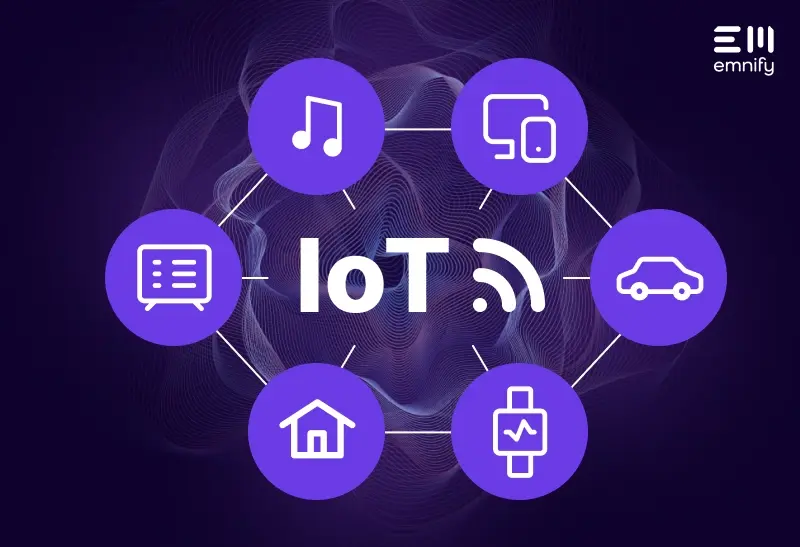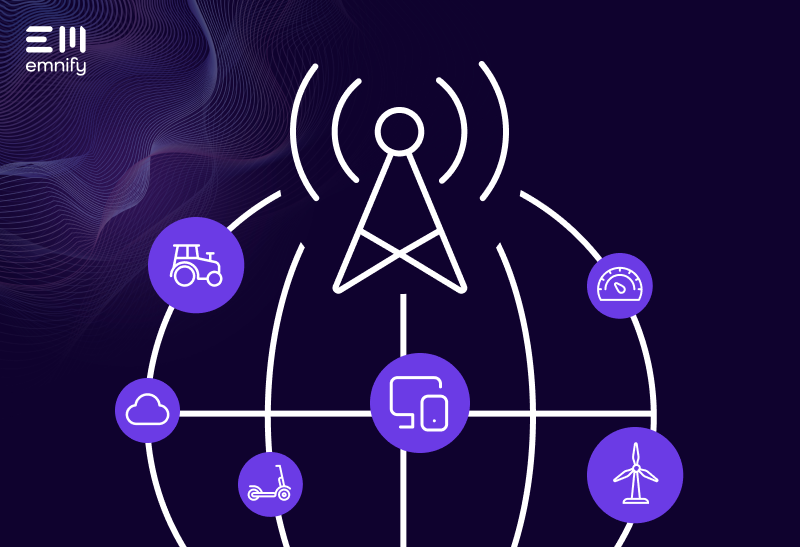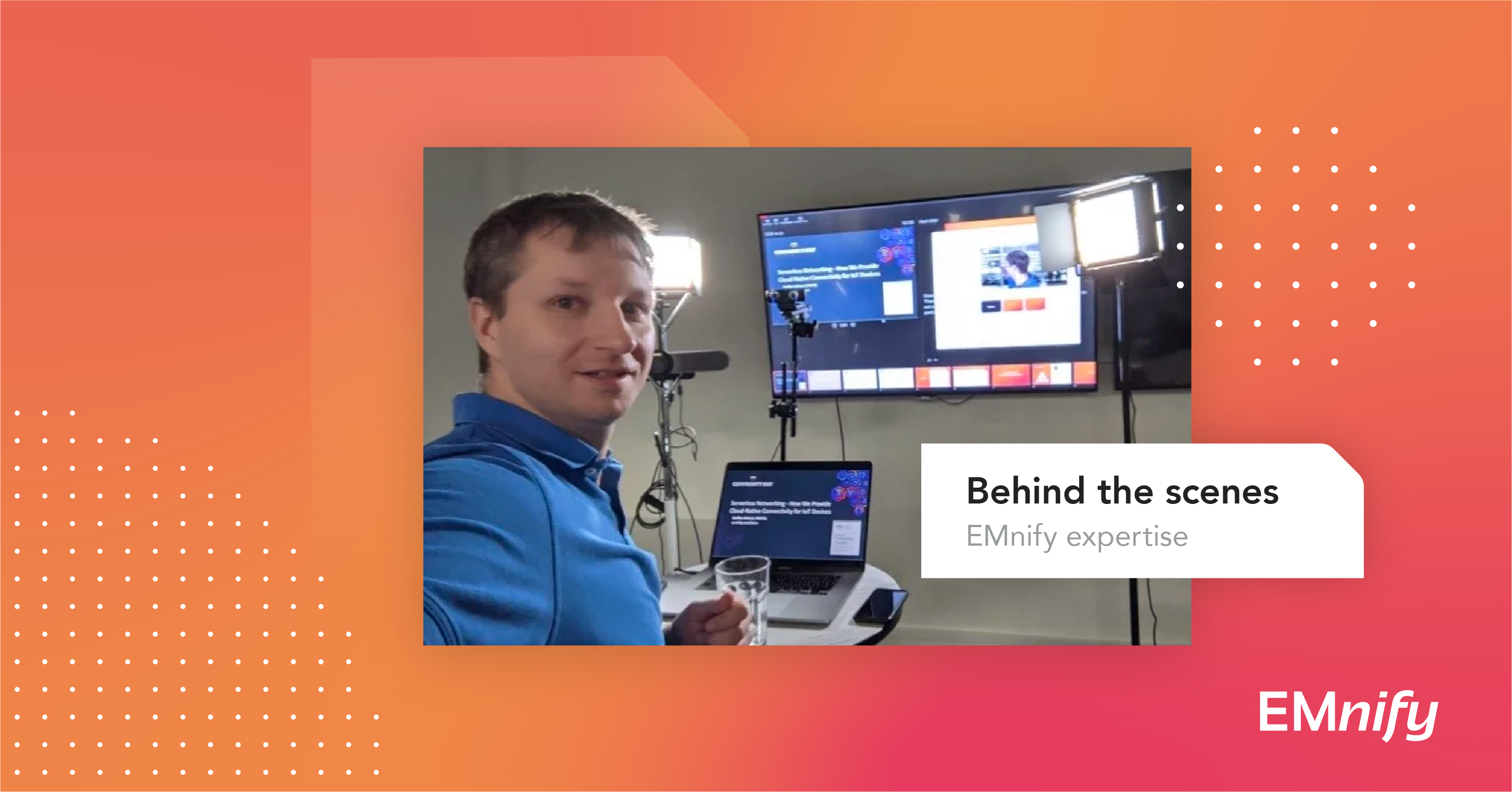

emnify marketing recently sat down with Director of Tech & Infrastructure, Dr. Steffen Gebert, who recently delivered two specialist talks, at key industry events, about how emnify implements its globally distributed IoT connectivity platform. You can find the links to the two talks at the end of this article.
emnify Marketing: Steffen, your current position is Director Technology, Infrastructure. Before we discuss your recent talks and your experience with COVID-19-compatible online conferences, would you share with us your story, what brought you to emnify and into this position?
Steffen: I joined emnify back in 2017 as the fourth developer in the company. Back then, we were really a small startup. Before that, I did my PhD at the University of Würzburg on the topic of software-based networking. The majority of research activities were happening within the framework of international research projects on virtualized mobile core networks. Software-defined networking (SDN) and Network function virtualization (NFV) were the two major enablers here. Luckily, I found out about this tiny startup emnify, which was not only topic-wise a perfect match, but also only 3km away from my previous working place at the university. Since then, I worked in our Core Networking team, was part of our (no longer existing) operations team, and finally took over the responsibility for emnify’s cloud infrastructure. My core technical competencies and interests are networking and AWS, and I’m happy to work together with many other domain experts. With that knowledge, I work together with our teams to implement and operate our fully virtualized mobile core network running on AWS.
emnify Marketing: You recently shared your achievements in two online talks, one at DENOG, the other one at an AWS Community Day. These two tech communities appear fundamentally different. Are the topics with which you work at emnify also so diverse?
Steffen: First of all, I had the privilege to share our achievements and experiences to which several people and teams across the whole organization had contributed. Both projects that I was covering lasted for several months and our success was only possible due to the dedication of my colleagues.
Regarding the diverse nature of the two events and communities, I would absolutely agree. The DENOG is the German Network Operators Group, which consists of typically network engineers affiliated with Internet Service Providers (ISPs) or data center and hosting providers. If you look at the agenda, it was packed with deep dives into networking topics, and in most cases, people were talking about hardware-based solutions.
As the name suggests, the AWS Community Day – Bay Area was filled with talks about totally diverse topics, but everyone implemented their solutions on top of AWS.
Personally, I like the intersection of networking and the cloud. Software-based networking puts things often upside down and the virtualized network functions offered by AWS are impressive. Similarly, we at emnify innovate at a high pace and let our network behave in completely novel ways – often fundamentally different from how networking vendors or specifications like 3GPP envision it. But one cannot do this without understanding the fundamentals of networking.
The commonality between the two talks is that both are related to how our customers’ IoT devices exchange their IP traffic. The DENOG talk was describing how we implement our next generation interconnection to the mobile carriers. Imagine this as the part of how IoT sensor data gets into our system. The AWS Community Day talk was about how our customers’ AWS deployments can secure device communication and data transport in a cloud-native way without additional VPNs. This can be imagined as how the sensor data then gets out of our system.
emnify marketing: According to your talk at DENOG12, you are now working with physical routers as well. Did emnify’s strategy change to move away from AWS?
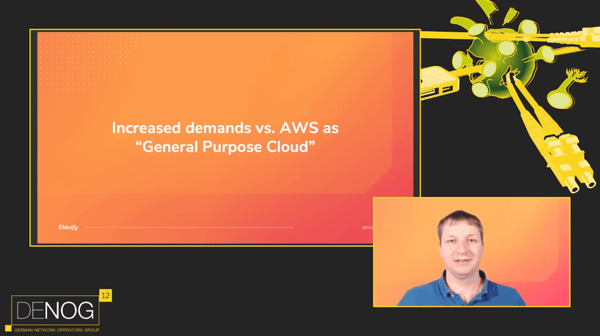
Steffen: Certainly not. Running on AWS makes our life so much easier - I really don’t want to miss that. However, products like ours are in some regards far off from mainstream applications. To meet the expectations of our customers – and, of course, of our own – on how we continuously improve our platform, a larger re-architecture was required to make a big step forward. To move to dedicated leased lines for our peerings with multiple mobile network carriers, which connect us with all the mobile network operators worldwide, we had to move certain logic outside of AWS. For that, we put physical Juniper routers into place. The complexity of the routing logic that these routers take over is trivial. However, the integration into our otherwise fully cloud-based tooling and processes was challenging. We did not want to give up comfort and safety, or maintain completely separate monitoring systems. If you are interested in how we solved this, then please enjoy the talk.
emnify marketing: In your AWS Community Day presentation, you share how emnify’s Cloud Native Connectivity using AWS Transit Gateway was implemented. Why do you think this feature makes our customers happy?
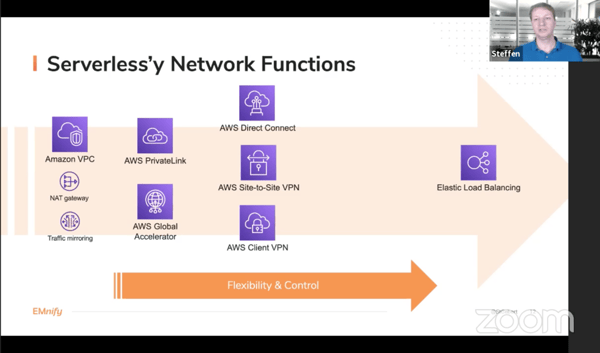
Steffen: Luckily, I think it also makes our life easier. Everything that we can delegate to AWS to run it for us is something that we don’t have to worry about, and gives us time for other work. We made use of AWS Transit Gateway, which can be understood as a serverless router. This was the first time that we were able to build a feature that handles customers’ IP traffic using a serverless offering. Before, we always had to rely on our own EC2 instances for this. The operational and maintenance effort now is dramatically lower compared to before.
From the view of a customer running on AWS, I would absolutely try to avoid running own VPN gateways in my AWS account just to connect to my IoT connectivity provider. Implementing this in a scalable and highly-available way is a major effort. We at emnify used to take care of such things, but connectivity is our product. For our customers, this is not where they generate business value – they want their application up and running and secure and stable connectivity to their IoT devices. With our Cloud Connect feature and AWS Transit Gateway, this is a matter of 5min and from then on, AWS takes care about keeping it running.
emnify marketing: These were your first two talks at online conferences. How did that feel?
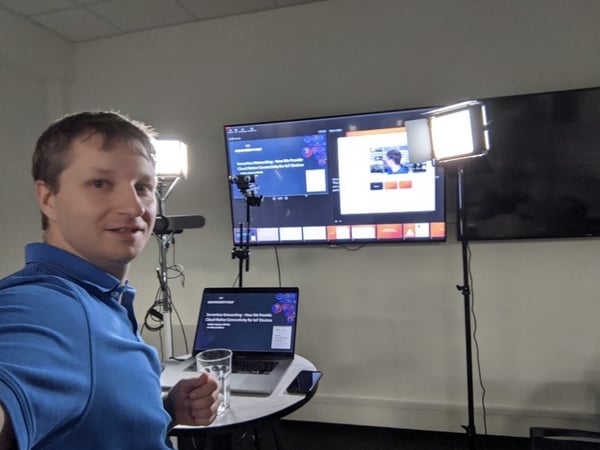
Steffen: I even can’t recall having ever given a webinar presentation, I’m not a Twitch streamer and don’t create YouTube videos in my spare time. Yes, this was really a novel experience for me. Shortly before the first presentation, while I was setting up our new webinar studio in our Würzburg office, I was questioning, whether this provides an authentic environment or whether I’m over-engineering with the light, microphone, and camera setup. I knew many other speakers would give their presentation from their normal desk. Especially after the DENOG conference, where I admit that I was moving way too much in front of the camera, I was doubting, whether the audience of an online conference would expect speakers to sit at their desk with their eyes watching a bit below the camera – just as we’re used to from the video calls we’re having each all day long. Thankfully, a colleague pointed me to this video of Gene Kim, an author and conference organizer that I admire. This confirmed me to keep the setup also for the second talk mostly as I had – good lighting, standing up, camera in the line of sight, etc. And that nobody laughs when I make a joke on stage is also nothing new ;-)
Nevertheless, I miss the interaction with peers that one has at physical conferences. This is not limited to getting deeper into detail with questions after my talks. As a meetup organizer, I also like to discuss with IT colleagues and hear about their day-to-day successes and failures.
For the experience as a speaker, I think similar rules apply as for physical events: Clear and timely communication of conditions and expectations. Knowing early, how much time should be reserved for Q&A, whether PowerPoint can be used in the streaming environment or the slides will be converted to PDF etc. Learning those things hours or minutes before the talk was and is a stress factor.
Nevertheless, it was an interesting experience, I got in contact with a few, but very interesting peers – probably thanks to the bigger audience – and I didn’t have to travel at all.
Get in touch with our IoT experts
Discover how emnify can help you grow your business and talk to one of our IoT consultants today!
David Garcia brings his passion and over 8 years experience in IoT/IIoT to Product Marketing, along with Extensive experience in Utilities, Energy, Transportation, Manufacturing vertical markets.
